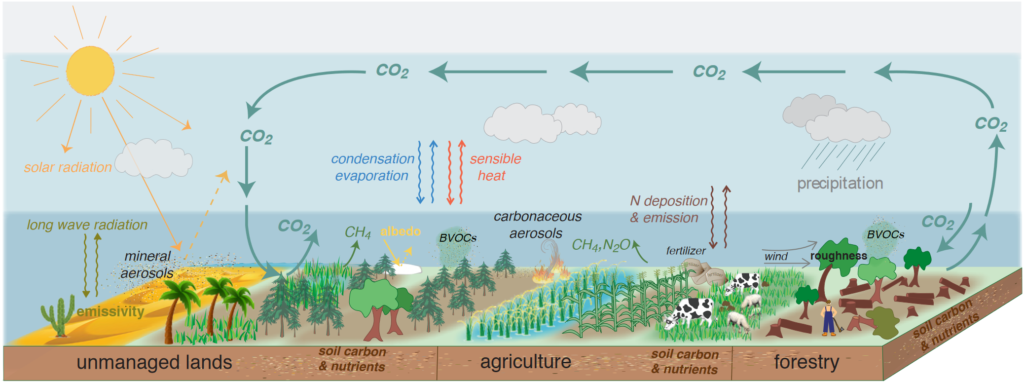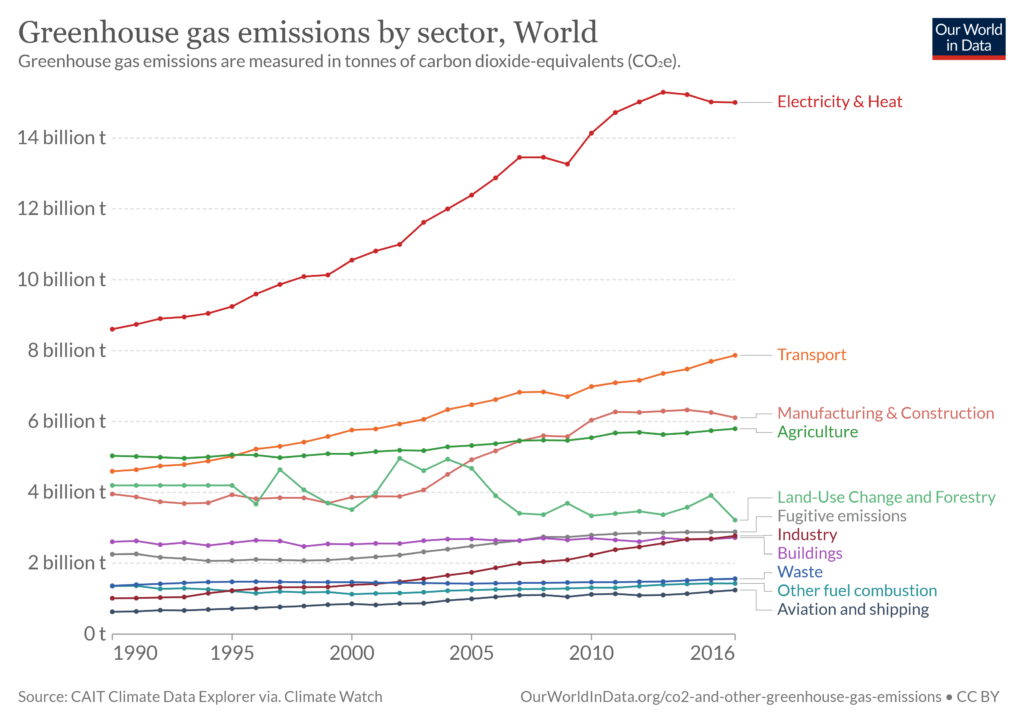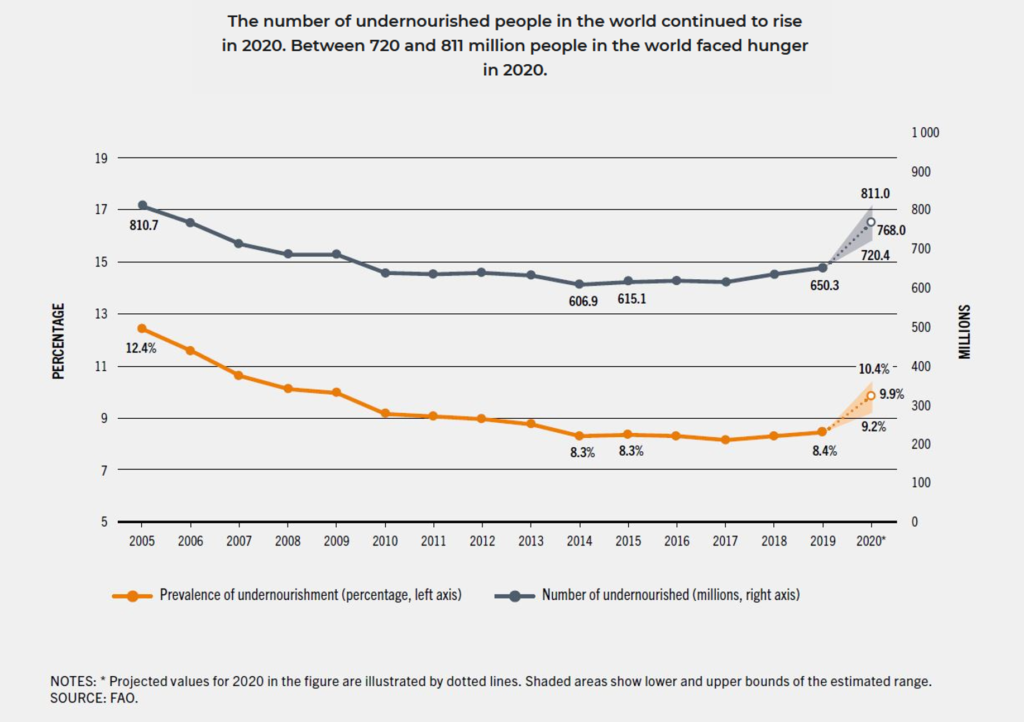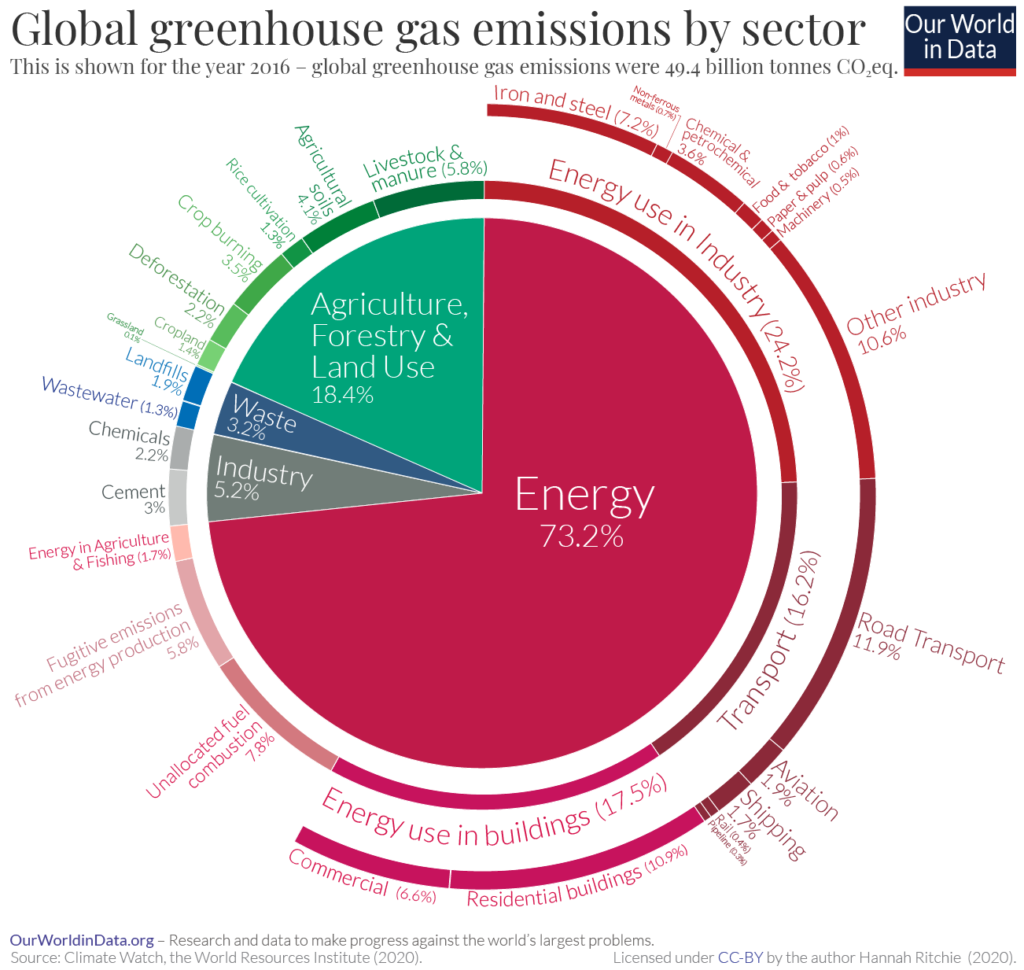Food and climate, environment, society, and economy – old
Food systems depend on natural resources just as much as they can impact them. It is therefore worth taking a closer look at their interlinkages.
How do we use our resources?
Water, land and climate are essential resources for agriculture.
Explore this map of global land use for food production per country. – Maybe this should be the percentage instead of absolute numbers
Source: Food and Agriculture Organization (FAO), OurWorldInData.org/land-use
Agriculture takes up a big part of our land. Only around 71% of the global land resources is habitable and from that land, half is used for agriculture. From all agricultural land, 77% is used for livestock and dairy farming, and only 23% is used to grow crops. However, those crops provide 82% of our calories and 63% of our protein.
[insert land uses pie chart: 50% agriculture, 11% grasslands and shrubs, 37% forests, 1% freshwater, 1% urban, ourworldindata.org/land-use]
[option: insert interactive video with guessing questions]
As displayed below, the share of freshwater used for agriculture differs across regions. On average, it represents the main use of freshwater globally.
Globally, 70% of Freshwater is used for Agriculture
Source: https://blogs.worldbank.org/opendata/chart-globally-70-freshwater-used-agriculture , data from :World Development Indicators
Agriculture supports the livelihoods of billions of people, making a substantial contribution to economies. Global agriculture continues to evolve and develop to meet our demands. But: It threatens natural resources and contributes to climate change.
Food, climate & environment
Food production is embedded in the Earth’s natural environment. All ecosystems, managed or unmanaged, interact with land, water, and the atmosphere, depending on the way they are structured and how they function. Their albedo and emissivity affect the amount of solar and long-wave radiation which is absorbed by land and reflected or emitted to the atmosphere. Surface roughness influences turbulent exchanges of momentum, energy, water and biogeochemical tracers. Which and which amounts of greenhouse gas emissions (GHGs) and precursors of short-lived climate forces (SLCFs) like mineral dust and biogenic volatile organic compounds (BVOCs) are released to or removed from the atmosphre by land ecosystems modulates the atmospheric composition. Regional climate is affected by atmospheric aerosols that are formed from these precursors by altering the amounts of precipitation and radiation reaching the land surface through their in clouds physics (IPCC 2019: 44).

Current climate change is already affecting food security, as rainfall patterns change and temperatures rise. A small increase in average temperature already leads to a large increase in the frequency of extreme temperatures and extreme weather events. The Intergovernmental Panel on Climate Change (IPCC) dedicates a chapter in the Special Report on Climate Change and Land to food security and shows how current and future climate change impact the food system in different ways.
Big impacts of climate change on food:
A suggestion for presenting below points. (Grouping them on slides with some fancy photos):
The impacts of climate change on agriculture are manifold and vary across regions, crops, and food production practices, and has different dimensions. These include effects on crop productivity, food quality, risk of harvest failure, risk and patterns of pests, crop and livestock disease, as well as of post-harvest losses.
Crop yields: Climate change is already impacting the yields of a number of crops, although differently in different regions. Although some crops like maize and wheat have benefitted in many higher-latitude regions, they have been negatively impacted in many lower-latitude regions. Warming, in particular when combined with drying effects of climate change is having adverse effects on yields, which is true in parts of the Mediterranean. Negative effects can also be observed in the African drylands and in the high mountain regions of Asia and South America. And although crop productivity is projected to benefit from increasing CO2 levels at lower temperature increases, the nutritional quality is likely to decrease (i.e., less protein, zinc, and iron in cereals).
Fruit and vegetable yields are likely to suffer from projected higher temperatures, especially in tropical and semi-tropical regions where heat stress reduces fruit set and subsequently yields. Impaired product quality, and increasing food loss and waste are further effects. However, in some cases, warmer temperatures entail longer growing seasons and the possibility of a greater number of plantings and harvests per year.
Climate extremes: Extreme weather events can disrupt food systems in different ways. They impact farming, as dry spells, heat waves or torrential rainfall and cascading effects like fire, flooding, and landslides threaten crops and livestock directly. Likewise, hazards disrupting other parts of the production, processing, and retailing infrastructure (e.g., fertilizer supply, food stocks, markets) entail yield reduction and food loss.
Livestock: Pastoralist livestock production systems may be the most directly affected by the climate. Pastoralism is practiced by 200-500 million people, including nomadic communities, transhumant herders, agropastoralists. Impacts of climate change are pronounced in Africa, where pastoralists are likely to experience its effects through lower pasture, lower animal productivity, lower reproduction rates due to damaged reproductive function, as well as a loss of domestic biodiversity.
Fisheries and aquaculture: The ocean has acted as a buffer to climate change by absorbing 93% of additional heat since pre-industrial times and sequestering 30% of the emitted anthropogenic CO2. As a consequence, aquatic systems are undergoing significant changes which are projected to be accentuated in the future. Light, temperature, water chemistry and nutrients impact primary production in marine and freshwater systems in a complex way. A decline in primary production in the ocean by three to nine percent by 2100 has been forecast and varies regionally for freshwater systems. However, projections for both marine and freshwater systems are highly uncertain.
Big impacts of food on climate:
21-37% of total GHG emissions are attributable to the food system, which impacts the Earth’s climate in multiple ways, directly and indirectly. GHG emissions accrue when carbon sinks like forests or peatland are cleared or drained to accommodate agricultural production, and their carbon sequestering function thus lost. Land management practices like burning, and certain food production systems in particular like rice cultivation and livestock directly contribute to the amount of GHG gases in the atmosphere. But also all other activities around food production which require energy, like processing, packaging, storage or the transport to markets, increase the footprint of our food on climate. The figures below give an impression of the relative contribution to global GHG emissions by sector and of their recent developments in total numbers.
Agricultural emissions have increased in the last 20 years due to rapid growth in agricultural production

The IPCC projects that, with an increasing global population, income growth and dietary transitions, GHG emissions from agriculture and livestock are likely to increas by another 30-40% by 2050, if no countermeasures are taken.
On the food supply side, sustainable production systems have the potential to decrease emissions intensity from crop, livestock, and agroforestry systems. Certain management practices can increase soil carbon sequestration, reduce N2O emissions from fertilizers, and allow to cultivate rice at lower levels of CH4 emissions. Livestock is an important contributor to GHG emissions, and particularly so when the food output is compared to the output of other production systems with relatively lower resource requirements and GHG emissions per unit. However, better grazing and manure management can reduce emissions and increase soil carbon stocks. In comparison, fishery and aquaculture are only a minor contributor to global GHG emissions. Here, the emissions stem mainly from the energy consumption of fishing vessels, transportation and storage.
GHG emissions of the food system are likewise caused by dietary choices. On the consumption side, diets high in coarse grains, pulses, fruits and vegetables, nuts and seeds, with only a low portion of animal-sourced foods, do not only yield the promise of positive health outcomes, but also to be more sustainable in terms of climate and the environment.
Across the food system, food loss and waste constitute a major issue. Not only is up to a third of total food produced lost or wasted. In 2010-2016, global food loss and waste accounted for 8-10% of total anthropogenic GHG emissions. Food loss is the food lost due to poor storage, handling practices or infrastructure before it reaches the consumer. Food waste is the food that has reached the retailer or consumer, but is not consumed because it is left to spoil or otherwise discarded. Typically, ratio of food loss to food waste differs substantially between developed and developing countries.
Soils sustain agriculture and stock carbon
Soils play a crucial role in the Earth’s system of energy and matter flows and thus also in our food systems. They sustain agriculture, support pasture for livestock keeping and influence fish habitats by the sediment and chemicals that are eroded and leached from them and transported into water bodies. Soils are the world’s largest terrestrial carbon sink. Therefore, they have the capacity to buffer climatic changes. Vice versa, soils emit climate change enhancing GHGs when they are degraded.
Soil Organic Matter (SOM) is critical for the stabilization of soil structure, the exchange of plant nutrients and water infiltration and storage. Soil Organic Carbon (SOC) is its main component. It is what is left in the soil after any material produced by living organisms has been partially decomposed. Decreasing SOC in soils indicate soil degradation, as entailed by unsustainable management practices, which decreases soil health and negatively affects food production. Worldwide, a third of the soils are degraded according to the Status of the World’s Soil Resources (SWRS) report, which puts food security and climate change mitigation goals at risk.
On the flip side, reversing soil degradation and building up SOM yields great potential to improve water and nutrient availability and thus food productivity, as well as to slow down climate change by decreasing the concentration of CO2 in the atmosphere. Moreover, food production systems grow more tolerant towards extreme climate phenomena like drought if the SOC in soils is improved. A small increase in of SOC in the top soil (0-30 cm) could improve drought tolerance through increased fertility and efficient water use of the food production systems over 70% of the harvested area worldwide, and particularly so in drylands. Closing the gap between current and upper limit of tolerance levels of SOC in soils globally has the potential of increasing farmers’ economic output by about 16% in drought years and of co-benefitting the climate by reducing global decadal mean temperature warming by 0.011°C. Rendering land management more sustainable is a crucial step towards leveraging this potential.
Browse the UN FAO’s Global Soil Organic Carbon Map (GSOC), which is a joint mapping effort of currently 88 contributors. Notice the spatial differences. Some ecosystems’ soils like the Great Cuvette’s swamps in the Democratic Republic of the Congo are particularly rich in SOC.
http://54.229.242.119/GSOCmap/
Food, society & economy
The natural environment plays a crucial role for food production. But food, society, and the economy are also interconnected.
Agriculture is a big economic factor globally. The agricultural sector employs around one billion people and 2.6 billion people depend on agriculture for their livelihood. The total market value of crop production is 10 trillion €/year, so agriculture is a large part of our economy and society.

[Ask Andy for original map]
Agriculture is also becoming more and more efficient in providing the global population with food. We only use one third of the land for a unit of food, compared to the land needed in 1961. Technology has helped us grow more food on the same amount land, e.g., thanks to new, higher yielding varieties, improved land and water management, and the increased use of artificial fertilizers.
However, these improvements have not resulted in equal benefits around the world. In the graph below, all cereal production in 1961 was scaled to 1 to see where the gains are over time. Yields have increased substantially in some regions in the world, but comparably only very little in others. The gains from new technology have not been the same everywhere. Most parts of Asia benefitted from the Green Revolution, consisting mainly of new varieties, improved irrigation and fertilizer use, but most of Africa did not.

The maps below substantiate the claim of geographically unequal trends. They show how many calories were available per person in 1961 and in 2014. Those countries that are dark blue were able to supply sufficient food to their population to meet their caloric needs. But in some parts of the world, particularly in southern and central America, Africa, and Asia, countries were not able to do so in 1961. By 2013, many of those countries have increased their ability to provide sufficient food. However, it is still not ideal in all parts of the world.
https://ourworldindata.org/grapher/daily-per-capita-caloric-supply?time=1961
https://ourworldindata.org/grapher/daily-per-capita-caloric-supply?time=2014
Besides the amount of available calories per person in a world of a still growing population, the type and quality of food that is consumed can be considered. This plays a role when it comes to health outcomes on the one hand. On the other hand, the demand for certain food groups has an effect on food provision and thus also on the related use of natural resources. Dietary transition from cereal- to protein-, and particularly meat-rich diets can be linked to income growth and urbanization trends. While urbanization was a phenomenon of high-income countries until the 1970s, low-income countries are experiencing high urbanization rates since. In fact, livestock production has been one of the fastest growing agricultural subsectors in low-income countries. Globally, per capita consumption of meat has almost tripled since the early 1970s, and per capita consumption of fish has more than doubled. Other social factors that play a role in food security are gender and equity, age, ethnicity, wealth, and class. Different groups tend to different food requirements, dietary choices, roles in the food system, or are more vulnerable or more resilient to food insecurity. Thus, for example, expected cereal price increases due to the effects of climate change will have varying impacts across regions and groups.
There is evidence that our food supply systems can adapt to the challenges of meeting future food demands. However, despite the substantial improvements in food production, over 800 million people still suffer from hunger and 2 billion are malnourished. And despite the overall trend of declining hunger, the uptick since the middle of last decade is concerning. The harsh rise in the number of undernourished people, which can be attributed to the COVID-19 pandemic, uncovers the vulnerability of food systems to societal shocks.
for the below graph: get the data from for interactive chart:
https://unstats.un.org/sdgs/report/2021/goal-02/

To sum up, many factors play a role when looking at food systems and food security. Food system activities, climate and the environment, and society and the economy, all influence food system outcomes, as well as one another. In turn, food system outcomes have an impact on climate and the environment, and society and the economy. When looking at food security, all aspects and layers of these complex interlinkages need to be considered in their spatial and temporal dimensions.

Sources & further reading
Friel et al. 2020: The nexus between international trade, food systems, malnutrition and climate change
Bonilla-Cedrez et al. 2022: Fertilizer and grain prices constrain food production in sub-Saharan Africa
https://www.fao.org/3/i6583e/i6583e.pdf
Alexandratos and Bruinsma, 2012. Mbow,C.,C.Rosenzweig,L.G.Barioni,T.G.Benton,M.Herrero,M.Krishnapillai,E.Liwenga,P.Pradhan,M.G.Rivera-Ferre, T. Sapkota, F.N. Tubiello, Y. Xu, 2019: Food Security. In: Climate Change and Land: an IPCC special report on climate change, desertification, land degradation, sustainable land management, food security, and greenhouse gas fluxes in terrestrial ecosystems [P.R. Shukla, J. Skea, E. Calvo Buendia, V. Masson-Delmotte, H.-O. Pörtner, D.C. Roberts, P. Zhai, R. Slade, S. Connors, R. van Diemen, M. Ferrat, E. Haughey, S. Luz, S. Neogi, M. Pathak, J. Petzold, J. Portugal Pereira, P. Vyas, E. Huntley, K. Kissick, M. Belkacemi, J. Malley, (eds.)]. In press.
Barange, M., Bahri, T., Beveridge, M.C.M., Cochrane, K.L., Funge-Smith, S. & Poulain, F., eds. 2018. Impacts of climate change on fisheries and aquaculture: synthesis of current knowledge, adaptation and mitigation options. FAO Fisheries and Aquaculture Technical Paper No. 627. Rome, FAO. 628 pp
P.R. Shukla, J. Skea, R. Slade, R. van Diemen, E. Haughey, J. Malley, M. Pathak, J. Portugal Pereira (eds.) Technical Summary, 2019. In: Climate Change and Land: an IPCC special report on climate change, desertification, land degradation, sustainable land management, food security, and greenhouse gas fluxes in terrestrial ecosystems [P.R. Shukla, J. Skea, E. Calvo Buendia, V. Masson-Delmotte, H.-O. Pörtner, D. C. Roberts, P. Zhai, R. Slade, S. Connors, R. van Diemen, M. Ferrat, E. Haughey, S. Luz, S. Neogi, M. Pathak, J. Petzold, J. Portugal Pereira, P. Vyas, E. Huntley, K. Kissick, M, Belkacemi, J. Malley, (eds.)]. In press. https://www.ipcc.ch/site/assets/uploads/sites/4/2020/07/03_Technical-Summary-TS_V2.pdf
FAO Global Soil Organic Carbon Map leaflet https://www.fao.org/3/i8195e/i8195e.pdf


